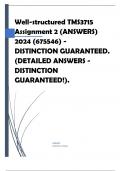Well-structured TMS3715
Assignment 2 (ANSWERS)
2024 (675546) -
DISTINCTION GUARANTEED.
(DETAILED ANSWERS -
DISTINCTION
GUARANTEED!).
ADMIN
[COMPANY NAME]
, Question 1 [40 marks] Use learning unit 1 ̶ Understanding the adolescent
learner and Learning Unit 2 ̶ Home language teaching, principles and
approaches in a multicultural society to answer the following questions (1.1,
1.2). (40 marks) Question 1.1 [20 marks] Elaborate on the various stages
experienced by adolescent learners, detailing their influence on your personal
philosophy regarding language teaching and learning. Use the following
guidelines to prompt your thinking. 1. Outline three phases of adolescent
learners as well as the physical, social and cognitive development
characteristics of experiences by adolescents at each of these stages. 2. Your
conception of how language learning occurs (use your knowledge of the
principles of language, theories of language acquisition and approaches). 3.
How your language teaching beliefs could affect your actual teaching
practices and how you relate to your adolescent learners.
Sure, let's address each part of the question systematically:
1. Phases of Adolescent Learners:
a. Early Adolescence (ages 10-13):
• Physical Development: This phase is marked by rapid physical growth, puberty onset,
and hormonal changes.
• Social Development: Adolescents start seeking peer acceptance, forming identity, and
may exhibit mood swings.
• Cognitive Development: Abstract thinking begins to develop, but logical reasoning is still
limited.
b. Middle Adolescence (ages 14-17):
• Physical Development: Adolescents experience further physical changes, such as growth
spurts, secondary sexual characteristics, and brain maturation.
• Social Development: Peer relationships become more influential, and adolescents start
exploring romantic interests and social roles.
• Cognitive Development: Abstract thinking improves, and adolescents become more
capable of hypothetical and logical reasoning.
c. Late Adolescence (ages 18-21):





